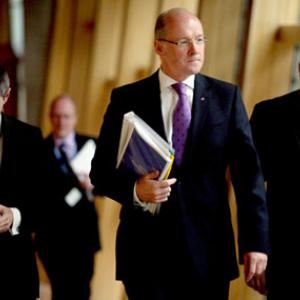Aligning public services to forge a sustainable legacy is the theme of this year’s UK CIPFA Conference and I’d like to explore this from a Scottish perspective.
I’d first like to say how pleased I was to recently receive honorary CIPFA membership. It’s been a pleasure working with members over the past eight years and our collaborative relationship will be instrumental in developing renewed arrangements for Scotland’s public finances.
Effective partnership working is, I believe, the basis of high quality public services and in Scotland all public services are aligned to a single performance framework – Scotland Performs. We are currently working with our partners to drive forward a comprehensive programme of reform to protect and improve public services. This process has been all the more challenging due to the significant and sustained pressure on public finances that has resulted from the continued programme of austerity being pursued by Westminster.
The austerity programme has failed by any measure. Not only has it delayed the economic recovery, it has also been ineffective in terms of reducing the deficit. The Scottish Government believes in a different approach. Our vision is for a prosperous economy where the benefits of growth are shared equally. That is why we have proposed a sustainable alternative to austerity, which would see moderate spending increases in each of the next five years.
Our programme for government – One Scotland – is founded on three, mutually reinforcing, priorities: inclusive growth, creating a fair and equal society, and protecting and reforming public services; all delivered through a more engaging and participatory approach. Strong public services are the bedrock of a fair and prosperous society and we will continue to invest in and prioritise these as far as we are able to using the powers available to us.
There is a consensus in Scotland that the report of Campbell Christie’s Commission on the Future Delivery of Public Services provided the right diagnosis for improving outcomes for communities across Scotland. These findings provided additional impetus to a reform journey that had already begun, informing a strategic approach to public service transformation built around the principles of performance; partnership; people and prevention. Since the publication of Christie, the importance of both place and participation have also become more widely recognised as being key in the design of any public service reform.
We are committed to decisions being taken closest to where they have their effect. Scotland’s 32 community planning partnerships provide a strong understanding of place, bringing public, private and third sector partners together with communities and each other to design services that are responsive to distinctive local priorities.
I want to see a greater shift in where power and influence lies, so that people are able to take an active role in shaping the society they live in. The wholly unprecedented levels of civic participation witnessed during the referendum debate on Scottish independence was an inspiration and our Community Empowerment Bill will support communities to achieve their own goals and aspirations – whether that’s by taking control of land or buildings or having a greater say in how local services are run.
A great example of public services working with a local community and each other to improve outcomes and tackle inequalities is found in Gallatown. This small community in Kirkcaldy is one of the most deprived in Scotland and traditionally was reluctant to engage with public agencies. Recently the people there entered into a dialogue to influence plans for a £1m project to transform derelict land into a community space and are about to begin a participatory budgeting exercise to deliberate on neighbourhood priorities and decide on the allocation of public money.
Much has been achieved since Christie reported, at both local and national level. A move to single police and fire services is generating efficiencies and strengthening connections with local communities. The reform of post-16 education has resulted in a smaller number of regional colleges offering skills more aligned to the needs of learners and local employers. And our investment in three change funds catalysed a shift towards prevention in early years, older people’s care and re-offending.
The integration of health and social care marks the next major phase in Scotland’s reform journey. At the beginning of April 2015, all territorial health boards and local authorities in Scotland submitted plans that bring together health and social care services, helping to shift towards a model of care that looks after the person at home or in a homely setting. Central to achieving this shift is joined-up planning and decision-making based on a single budget for care within a geographical area. New integrated partnerships will manage about £8bn – over 60% of the total health and social care expenditure in Scotland.
Also central to our reform ambition are digital public services. Digital technology provides a foundation for innovative, integrated public services that cross organisational boundaries and deliver responsively to people who need them.
Our digital public services strategy sets out how digital tools and technology and the better use of data can both drive and support improvements. I would highlight three things that I think are particularly important:
- First, to take concerted and common action to further developa national digital ecosystem of shared infrastructure, services and standards.
- Second, to push forward even faster on the development and implementation of online transactional services that are based on user needs and enable service improvements and operating efficiencies, and putting digital front and centre of all redesigns.
- Third, to make more effective use of data, particularly making use of data that organisations already hold.
Taken together, these areas for priority action have the ability to deliver a business transformation across the whole of the public sector.
Whether it’s ensuring patient care is seamless or grasping the opportunities digital technology offers, our ‘One Scotland’ approach is helping to deliver significant and lasting benefits to people across the country. Above all, we are guided by the values so clearly expressed by Christie, which put communities at the centre of public service policy and delivery.
It is this issue of public service alignment the UK CIPFA conference will consider and I commend this choice of theme, which promises to prompt some fascinating and important debate.
For details of the 2015 CIPFA Conference visit: www.cipfaannualconference.org.uk




















